There are many special events coming soon for our first graders! Please mark your calendar for the following: This week will be the last homework packet with a word study component. Math homework will continue until May 24. After Memorial Day, we encourage the children to continue reading every night. There is no school on Monday, May 27 for Memorial Day. On Thursday, May 30, our specials will run on a Monday schedule, so we will have P.E. but not library. On Friday, May 31, at 1:00 pm Mill Run will hold the First Grade Awards Ceremony. We will send an invitation with more information very soon. Field Day will be on Monday, June 3, with the rain date being Tuesday, June 4. Stay tuned for more information. Thursday, June 6 is the last day of school. We will have an End of the Year party from 1:00 - 2:00 pm. Please have your child bring his/her backpack to school every day until the last day, since we will send materials home a little at a time during the last 6 or 7 days of school. It's too much for the children to carry if we save it all for one day. In academic news, we will finish our math unit on computation strategies this week. This week and next, I will be giving several five-minute timed quizzes to assess the children's ability to recall addition and subtraction facts to 18. I will also check ReflexMath to supplement these grades. Thank you for reviewing math facts with your child. Confidence is so important! We are continuing with reading testing this week and next. The children do not need to study to prepare for this. Simply continuing healthy eating and sleeping habits is tremendously helpful. As mentioned before, I will provide a summary of your child's scores in the fourth quarter report card. They are doing quite well so far! In Social Studies, we will finish the year with a study of Australia, Alaska, and Hawaii, focusing on geography and wildlife. Finally, the LCPS Math Department recently sent a newsletter to teachers with some summer math activity suggestions. I thought I would share them with you, so that you can explore these links at your leisure. Enjoy! Summer Math Activities!
Check out these interactive and engaging math activities to share with students and parents!
Click each title to link to the website.
At Home With Math
http://mixinginmath.terc.edu/materials/athomewithmath.cfmThe ten everyday math activities on this site build math into the things most families already do—ordinary routines such as figuring out ways to save money, to share fairly, or to get somewhere on time. With these activities, children practice adding, subtracting, multiplying, dividing, and using other important math skills while doing tasks that are a regular part of life. Available in English and Spanish!
Math Playground http://www.mathplayground.com/Give your brain a workout with Logic Games, Number Games, Thinking Blocks for word problems, and much more!
Math in the Home Activities http://www2.ed.gov/pubs/parents/Math/index.htmlMath in the Home, Math at the Grocery Store, Math on the Go, and Math for the Fun of it—activities to engage students in problem solving, communicating, and reasoning about mathematics!
As
We have been using several games to practice recognizing coins and practice finding the value of a group of coins. A number of the children have asked me to share the games with you, so you can play together at home. 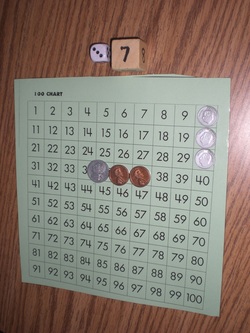 One of my favorite games is called "Show Me the Money."
Players take turns rolling two dice and showing that amount with coins. We use a one hundred chart as a game board, but you could play without one.
The player who rolls decides which cube will represent the tens place and which will be the ones. You can see we have one home-made number cube to provide larger numbers.
This example shows 37 cents. If both players agree that the coins and the dice match, they clear the board and it is the other partner's turn. Both players win.
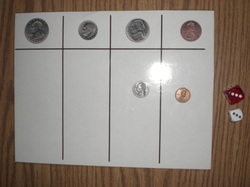 Another game is called "A Dollar Wins." The goal of this game is to accumulate one dollar's worth of coins.
The first player rolls two dice, adds them, and puts this amount in coins on the board. The example on the right shows six cents.
Then it becomes the second player's turn.
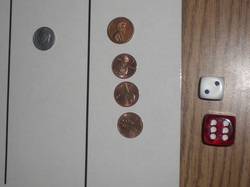 The second player rolls the dice, adds to find the total, and adds this amount to the board. Players must swap lower value coins that can be combined to trade for a higher value coin whenever possible.
In this example, player two rolled an 8 and added a nickel and three pennies to the board. The two nickels were then traded for a dime. The current total is now 14 cents. Players continue taking turns increasing the total until they reach $1.00. Both players win.
I hope you will enjoy playing one or both of these games at home. Not only do they provide great practice for mastering coin recognition and finding the value of a collection of coins, but they also reinforce place value and addition strategies.
Do you remember learning how to count the value of coins as a child?
With 668 Box Tops, our class sailed away with first place for the March Box Tops contest! Whoo Hoo! Thank you so much to all of our families for your diligence in checking for Box Tops and sending them to school. The children will all receive a coupon to CiCi's Pizza from the Mill Run PTO to mark this momentous occasion!
 The character trait for April is responsibility. We have been discussing what it means to be responsible, including doing what you are supposed to do without being told. Please discuss your expectations for responsible behavior with your child. Since we are also celebrating Earth Day this month, this is a perfect opportunity to link to how we can be responsible with our trash.
In a recent guidance lesson, Mrs. Fulkerson was able to congratulate both our star citizen for February, R.K. (right) and for March, N.T. (below). Well done, girls!
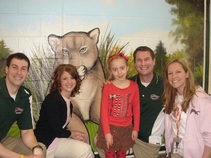 We have begun a math unit focusing on money. You can help your child practice identifying a penny, nickel, dime, and quarter. You can ask your child to tell you how much money you have with a small collection of change. You could also give your child an amount, and ask her to show which coins you would have to equal that value. Please encourage your child to find different combinations of coins to equal the same amount. Yesterday, the children found two solutions to this problem:
I have 6 coins in my pocket that equal 50 cents. What coins could I have?
In science, we are learning about natural resources. We will be focusing on the three Rs: reduce, reuse, and recycle. The children are pretty comfortable with reusing, since we use scrap paper quite often in the class. They also help with recycling. However, the concept of reducing the amount of trash we produce is a little more difficult. Thank you for discussing this at home.
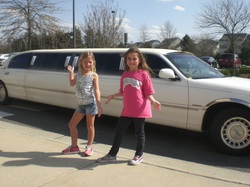 Finally, I thought you would enjoy this shot of R.K. and a friend getting ready for a ride in a limo with our three principals. R.K. won this prize at Mill Run's Carnival auction. How fun!!!
We are in need of several items in the classroom. We have almost depleted our pencil supply for the year, so any donations of pencils are most appreciated!
Also, for an upcoming project, we will need an abundant supply of items that might be in your recycling bin. Please send in any paper towel tubes, toilet paper tubes, various-size cardboard boxes (like cereal boxes, cracker boxes) and clean yogurt or tofu containers. We will also be grateful for any donations of clear tape, masking tape, duct tape, and string. If you're looking at something made of thin cardboard or plastic, and you're not sure, please send it in! I promise to recycle any materials that come in that we don't use. :-) I don't want to spoil the surprise of why we need so many materials, so please stay tuned to the blog. We will use these items the week of March 18. Many, many thanks in advance for your help!!
We have already collected more than 400 box tops, so we are getting very excited about our chances to win the March contest. Thank you to everyone for your help with this. Every box top helps raise money for our school!
In academic news, we will be finishing our math unit on fractions and moving into addition and subtraction. We will build on strategies we practiced in the second quarter to solve harder problems and story problems. We will also write our own problems. When solving a story problem, students will be asked to show their thinking in pictures, numbers, or words.
We are also wrapping up our unit on matter and beginning a unit on force, motion, and energy. Most likely this unit will continue into the fourth quarter, but we will begin by focusing on types of motion and pushes and pulls.
In reading, we are continuing to practice comprehension skills for fiction and nonfiction. In nonfiction, we are paying attention to key vocabulary, the author's purpose for writing, and formulating questions that can be answered in the text. In fiction, we are continuing to build fluency by reading in the character's voice, and we are thinking about our reading by visualizing what is happening and making inferences.
In writing we are finishing writing small moment personal narratives. We have begun to work with a writing partner to help plan our writing and revision. We are focusing on adding details to our writing to make our stories more vivid.
Coming Soon:
* Picture day is Tuesday, March 12.
* Wednesday, March 13, we will attend an assembly provided by our wonderful PTO. Wednesday is also "Wear Red" day for Youth Art Month.
* The Mill Run Carnival is Friday, March 15. By all accounts, this will be a fun family event. "Just chill!"
Our study of our national symbols focused on the flag, the bald eagle, the Statue of Liberty, and the Washington Monument. As you can see above, we culminated the unit with a project in the computer lab. The children were asked to draw a picture and write at least three sentences about their favorite symbol using the Pixie software. Now that we have finished the unit on U.S. Symbols, it is time to begin a quick unit on matter. In this unit, we are focusing on science standard 1.3, which reads, "The student will investigate and understand how common materials interact with water. Key concepts includea) some liquids will separate when mixed with water, but others will not;b) some solids will dissolve in water, but others will not; andc) some substances will dissolve more readily in hot water than in cold water." We will be squeezing in several experiments as well as building our nonfiction reading skills as we dive into our science textbook. You are welcome to reinforce your child's learning at home by conducting simple experiments to see how various materials such as vinegar, milk, baking soda, powdered drink mix, sugar, salt, sand, oil, soil, and rocks act when mixed with water. Making cookies for the sake of science? Definitely. It's a beautiful thing. In math, we have begun our study of fractions. In first grade, we focus on halves, thirds, and fourths. It is important that the children understand that a fraction represents a part of a whole, that fractions require the whole to be divided into equal parts, and that the fraction name tells the number of equal parts in the whole. We will also learn how fractions can describe part of a set. If I have three apples, two green and one red, I can say that 1/3 of the apples are red. Studying fractions at home can be very fun at snack-time. Pizzas can be divided into fractions, fractions of the pizza could have different toppings, and apples can be sliced into fractions as well. Enjoy! If you have the chance to visit Mill Run, please visit the bulletin board across from the cafeteria leading onto the kindergarten/first grade hallway. Our class was responsible for decorating the bulletin board for the month of March. We decided to link to Dr. Seuss' birthday and focus on reading. Each student interviewed his/her reading buddy, comparing their buddy's answers to the children's own responses. We asked: - Where do you like to read?
- What do you do to become a better reader?
- What is your favorite book?
Then, the children turned the interview responses into books. A brief self-reflection like this can be a very powerful tool to increase one's own confidence in reading. I encourage you to discuss the same questions at home as a family. As part of the Youth Art Month festivities, Mr. Browning is organizing a contest for three "color days" The first color day will be Wednesday, March 6, and the color is blue. Please help your child to pick out an all-blue outfit on Wednesday. Thanks for your help! Finally, many thanks go to AV's mom for sparking interest in the PTO BoxTop collection. If we all work together to check our pantries, tissue boxes, and ziploc bag boxes, we might collect enough to place in the March contest. Quite a few boxtops came in yesterday. The students will count them on Monday, and we'll keep you posted with how many we have. Thank you for your help!
The children were very excited to take part in a scientific experiment this week. This was a preview of concepts we will discuss in more detail later in the year during our unit on states of matter. This project will be on display during Mill Run's Science Expo February 6th. Here are the steps of our project:
Question: Can two types of matter be in the same place at the same time?
Hypothesis: We considered the materials needed and the procedure. We each made a prediction of what we thought would happen.
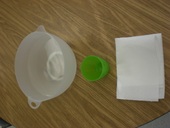
Materials: a bowl of water, a cup, and a paper towel
Procedure:
First, fill a bowl with water.
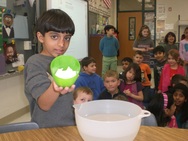 Then, crumple a small paper towel and stuff it in the bottom of a cup.
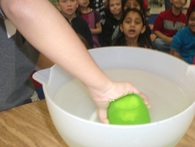 Next, turn the cup upside down and put it in the bowl. Hold it firmly. Count to ten.
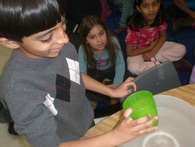 After that, take the cup out of the bowl.
Finally, look inside the cup.
Results: We discovered that the paper towel was still dry inside the cup. We noticed that when we placed the cup in the bowl, it made a smacking sound when it touched the water. Also, it took strength to hold the cup in position in the bowl.
Conclusion: We decided that two types of matter cannot be in the same place at the same time. Air was trapped inside the cup, and the air kept the paper towel from getting wet.
As we begin the third quarter, we are beginning some new units of study.In math, we are beginning a quick unit focusing on place value. We have been touching on place value all year during our calendar time within our morning meeting. Key concepts in this unit include:- understanding the expanded form of a two-digit number (74 = 7 tens and 4 ones),
- representing a two-digit number with a visual diagram of tens and ones, and
- solving to find the number when you add or subtract one, or when you add or subtract one ten (74 + 1 = 75, 74 + 1 ten = 84).
We will also continue using Reflex Math and the Math Masters program (aka Rocket Math) to measure our progress in recalling basic addition facts quickly and accurately. In reading and writing, we will use question words to enhance our understanding and our work. In reading, we will ask and answer wondering questions to monitor our understanding of the text. For example, Where is the story taking place? Who is important? What has happened so far? Why did the character do that? How did they get here? Providing the answers to questions like these can improve our written work as well. In social science, we are learning about famous Americans and their contributions to society. Specifically, we will focus on Benjamin Franklin, George Washington, Abraham Lincoln, George Washington Carver, and Eleanor Roosevelt. We have also learned about Martin Luther King, Jr. and Rosa Parks. Our "I can make a difference" essays, inspired by the work of Martin Luther King, Jr. are on display in the hallway. Question: If you were in charge of first grade curriculum for the Virginia Department of Education, what famous Americans would you add to our list?
This is a very exciting time of year in first grade. Many children make wonderful leaps of progress at this time. This is true in math as well as in our other subjects.
This week, I would like to give you a little more information about our approach toward addition and subtraction work at school.
We are using the Math Masters (or Rocket Math) program to build our ability to recall basic facts quickly and accurately. We also want to increase gradually the number of facts recalled in one minute.
For problem solving, we want the children to be able to apply multiple strategies. The screen shot below shows four addition strategies we have practiced in class. Some strategies are better suited for different problems. But the examples above give you a sense of how to apply them. For the problem, "8 +4", students could find the answer by:
* Counting on from the larger number. (In other words, don't waste time by counting from 1 to 8, then counting four more. Just start with the larger number and count from there.)
* Using a number line. Start with the larger number and make "hops" to add the smaller number. The number you land on is the answer.
* Drawing a picture. The best way to make this work is to draw a picture in groups of fives or tens, to easily be able to see the new total. In this example, we drew 8 circles and 4 triangles, starting with sets of 5. Then it is very easy to see that the total is 5 + 5 + 2 = 12.
* Use a related fact. Any useful fact can be applied to help solve a problem. Often doubles help. Often it is convenient to rearrange the numbers to make a set of 10, as shown above. When using this strategy for subtraction, the related fact might be the corresponding fact family fact. If I know that 8 + 4 = 12, then I know that 12 - 4 = 8.
We will continue to practice our computation skills in the second half of the year. Thank you for your continuing support of our work at home!
Mrs. Piper, the first grade assistant at Mill Run, sent a thank you note to the class. It reads, Dear Mrs. Hayden's Class, Thank you for the Starbucks gift card. It was so nice of you to think of me this holiday season. Love, Mrs. PiperIn content this week we are continuing our study of winter changes. We are learning about the changes that people, animals, and trees make in winter. You may want to discuss the following points with your child at home: - The temperature gets colder in winter.
- If it is cold enough, we will have snow instead of rain.
- The sun rises later and sets earlier in winter.
- Plants conserve energy in winter.
- Deciduous trees lose their leaves in winter.
- Evergreen trees keep their leaves year round. Most evergreen trees have needle-shaped leaves.
- People wear heavy clothes to go outside in winter.
- People may sled, ski, or go ice skating in winter.
- Many animals must make changes to survive the winter.
- Some animals (some bears, chipmunks, and mice) hibernate.
- Some animals (some whales, monarch butterflies, and geese) migrate.
- Some animals adapt. The Arctic hare changes its fur from brown to white to camouflage with the snow.
We are beginning a supplemental math program in class to practice and master quick recall of basic math facts. This program is called Math Masters, but your child may refer to it as "Rocket Math" since our score sheets have a picture of a rocket. The quiz will come home either with a star, indicating that your child met his/her goal and will proceed to the next level, or with a smiley face, indicating that your child should continue to practice the facts on that page and will try again next time. The goal number is derived from a quick measure of your child's writing speed. That way the math masters assessment is truly individualized for each student. Practicing math facts will be the substance of our math homework for the next several weeks. If you would like to help your child with additional math fact review, please click this link: http://quizlet.com/_arvl9 to access a set of flashcards online. Or, you can try the game called Scatter that is embedded below. Just match the addends with the correct sum.
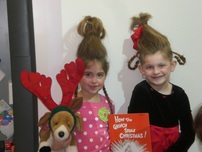 Life was very busy in the last week of school in 2012! We welcomed two guest readers, enjoyed a variety of Grinch Day activities, sang at the school holiday sing-along, and wrapped up the year with a classroom party. I am particularly grateful to ZP's mom, CB's mom, and NT's mom for organizing the party. Many thanks to all the parents who contributed to the party. The children seemed to have a wonderful time. I certainly enjoyed watching their joy!
I hope that you have been enjoying a relaxing and rejuvenating holiday season with family and friends. Most of my extended family gathered this past week, and now that we have returned home I am eager to see the children and learn about their holiday adventures.
I have just a few notes for you as we prepare to return to school on Wednesday, January 2.
In January, we will begin the Math Masters program (also known as "Rocket Math") to practice quick recall of basic addition and subtraction facts. More information on this program will go home next week.
Homework will resume the week of January 7. Homework packets will now include a writing component and word study activities will be reduced. Please see the homework cover page for details. Math homework will consist of practicing math facts in conjunction with Math Masters.
Finally, I am deeply grateful for your kind thoughts and generous gifts. Words do not adequately express my appreciation, so I must resign myself to a simple, "Thank you very much!"
We have begun our social science unit on economics. In first grade, that means we will learn about the differences between wants and needs, goods and services, and consumers and producers. Here are some ideas for you to support our learning at home: - Look around your home. Discuss which items are wants and which are needs.
- Discuss your job. Ask your child whether you provide a good or a service.
- Ask your child to help you identify ways you are a consumer. Have you ever been a producer?
- Discuss the importance of saving money and making wise choices about spending.
In math, we have begun a unit on graphing. In graphing, we will explore the following questions: - How do we collect data? We can use a survey.
- How can we represent the data we collect? We can use a table, bar graph, pictograph, or a tally chart.
- Why is it important to represent the data accurately? We want our audience to be able to interpret our graph.
- What language can we use to interpret a graph? We can discuss results using terms like more than, less than, fewer, greater, equal, and about. For example, "There are more students bringing lunch from home than students buying lunch today." Or, "Fewer students will buy a salad than students who will buy pizza."
Thank you for your support with practicing the sight words listed on our word wall. It is wonderful to see the students gaining confidence with reading and writing these words. Mastering these will help the children make connections to other words. I will close with one of my dad's favorite jokes. :-) Why did the chicken cross the playground? . . . . To get to the other slide!
|











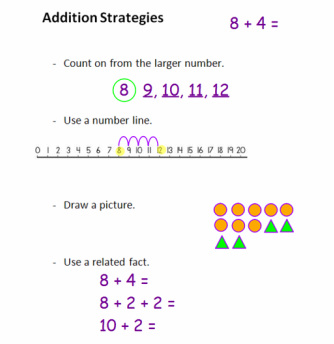

 RSS Feed
RSS Feed